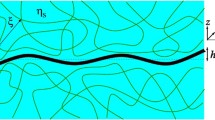Summary
Membrane processes such as microvilli and folded structures greatly increase the area for passive transport. A mathematical analysis of flows through folded membrane structures demonstrates that the increase in flows is not proportional to the increase in area. Furthermore, the flows of salt and water do not increase in the same ratio: that of water can be several times the increase in area and that of salt a fraction of the increase in area. A preferential passive flow of water is created by the structure. It is only in the neighborhood of the isotonic state that the effect is significant, but in that region, the effect can be dramatic.
A parameter study shows that the effect is most sensitive to the relative dimensions of the folded membrane structure and to the salt permeability. The effect of stirring within the folds is also studied. In the general case, the system of two-dimensional diffusion equations is integrated numerically; an analytical solution is presented for the special case of negligible convection coupling. The calculations show that salt-concentration profiles within the folds establish a distribution of thermodynamic driving forces across the membrane barrier which differs significantly from that found across a plane membrane separating the same bathing solutions. The overall behavior of the flows through folded membrane structures is thus nonlinear.
Similar content being viewed by others
References
Diamond, J. M., Bossert, W. H. 1967. Standing-gradient osmotic flow.J. Gen. Physiol. 50:2061.
Kedem, O., Katchalsky, A. 1963. Permeability of composite membranes: Part I.Trans. Faraday Soc. 59:1918.
Segel, L. A. 1970. Standing-gradient flows driven by active solute transport.J. Theoret. Biol. 29:233.
Author information
Authors and Affiliations
Rights and permissions
About this article
Cite this article
Richardson, I.W., Ličko, V. & Bartoli, E. The nature of passive flows through tightly folded membranes. J. Membrain Biol. 11, 293–308 (1973). https://doi.org/10.1007/BF01869827
Received:
Issue Date:
DOI: https://doi.org/10.1007/BF01869827




